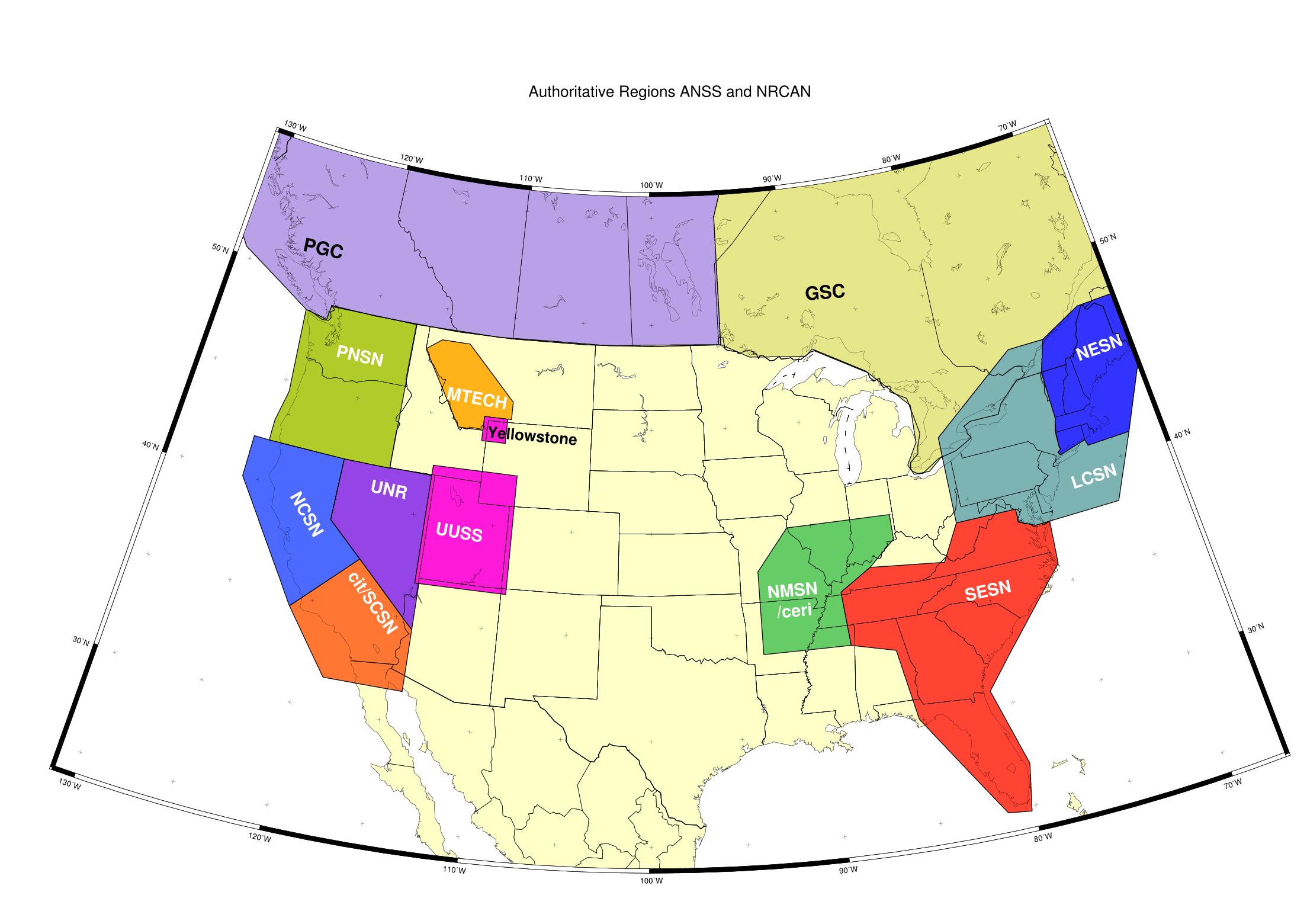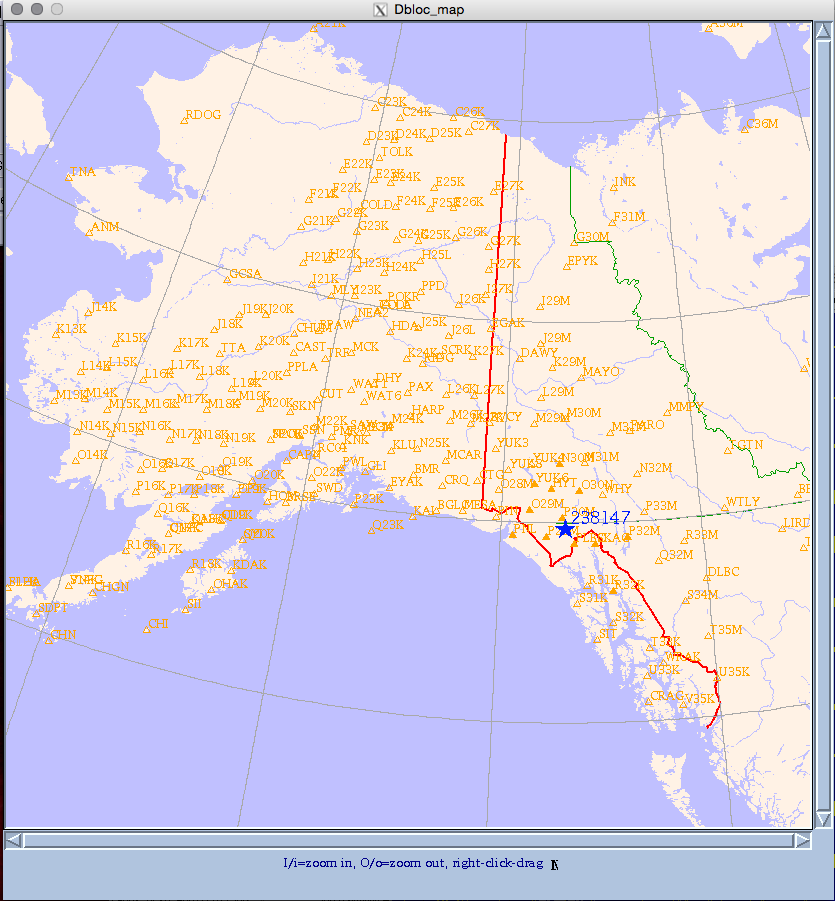ANF automatic processing and analyst seismic event review procedures
Last updated: February 26 2021 17:49:45 (UTC). by Jennifer Eakins
Contents
- Introduction
- What types of events were included?
- Who performed the analyst review?
- What were the procedures that added picks and event locations?
- When were there procedural changes and what were they?
- First P/S only or Pg/Pb/Pn/Sg/Sb/Sn labeled picks?
- Locations using dbgenloc or dblocsat?
- When were S picks included/how?
- When did we simply include AEC reviewed picks?
- Change in external bulletin associations
- What are some of the known issues?
Introduction
The EarthScope USArray Transportable Array project utilized many analysts over the past 16+ years of operations: some for a few months, some for years, and some for the entire duration of the project. From student interns, to staff, to project PI, many different eyes have reviewed the data analyzing the picks for multitudes of seismic events (earthquakes, blasts, unknowns, etc.) with the purpose of quality control for the data and creating at least a preliminary bulletin that could be a starting point for research projects.
This document is intended to: introduce the bulletin user to the analysts whose picks will be seen in the arrival tables, touch on some of the choices made for event processing and how event processing may have changed over time, and any known issues that might be relevant to an enduser.
What types of events were included?
Any event that has seismic energy and was able to be located. This includes mining activity along with earthquakes, both local and teleseismic. No attempt was made to distinguish between event types.
Who performed the analyst review?
Here is a list of analysts who have had eyes on the data. Included are both the username as it appears in the auth field of the arrival table, status as student or staff, as well as an approximate time during which their picks may appear in the database.
Note that reviewed pick time may pre-date their time of employment as older data may have undergone re-review during their tenure.
| Auth | Name | Status | Time |
|---|---|---|---|
| ahindley | Alison Hindley | Student | 12/2004 - 12/2006 |
| aquan | Alex Quan | Student | 05/2008 - 01/2009 |
| dbevproc | autopick | - | 04/2004 - present |
| dsamilo | Dane Samilo | Student | 09/2006 |
| eakins | Jennifer Eakins | Staff | 04/2004 - present |
| gkarasu | Gulsum Karasu | Staff | 09/2006 - 12/2002 |
| jtytell | Jon Tytell | Staff | 09/2006 - 06/2018 |
| krychert | Karen Rychert | Student | 02/2008 - 03/2008 |
| lastiz | Luciana Astiz | Staff | 01/2006 - 08/2014 |
| mcwhite | Malcolm White | Staff | 04/2004 - 07/2016 |
| rrodd | Rebecca Rodd | Staff | 01/2017 - 01/2018 |
| rt | F.Vernon/J.Eakins | PI/Staff | 04/2004 - present |
| tcox | Trilby Cox | Staff | 04/2004 - 02/2019 |
| tmulder | Taimi Mulder | Staff | 12/2006 - 09/2008 |
| vernon | Frank Vernon | PI | 04/2004 - present |
| vladik | Vladislav Martynov | Staff | 04/2004 - 08/2020 |
| wandaben | Wanda Bentkowski | Staff | 07/2008 - 09/2008 |
During 2015 and onward through 8/2020, we incorporated the picks from the analysts at the AEC (Alaska Earthquake Center) rather than duplicating analyst review work at the ANF. The list (may be incomplete) of AEC authors follows: Ian, dutylap, kenneth, kozyreva, miriam, natasha, dmerz, sara, alarm, mgardine, cpbruton, shwittaker, nmurphy, dbrazitis, glea, helena, trilbyc, annag, claina.
What were the procedures that added picks and event locations?
In short:
- Automatic snr pick and grid association, external bulletin association if available
- Quick review if a significant event (newsworthy, locally widely felt, middle of the night and someone found it really interesting, etc.)
- First pass review
- As of 2015, addition of outside picks from AEC
- Secondary monthly review/clean-up
Automatic processing
Seismic data was received in streaming fashion at the ANF in real-time. As the da ta was streamed into the Antelope orb, an automatic detection algorithm was run on all incoming seismic channels with a signal-to-noise test performed on filtered vertical traces (normally the 40sps data stream). Filtering bands were chosen to seek out both teleseismic and local earthquake signals. For the majority of the deployment: the broadband filter used was a 0.8-3.0 Butterworth filter and the local/regional was a 3.0-10Hz Butterworth filter. The detections were then gathered to find an associated event location based on spatial grid searches that determined a candidate hypocenter with move out times that best matched the observations. Once found, that automatic solution populated the real-time database of events with author fields listed as "tele" or "yukon", depending on the grid used to determine the location. An automatic magnitude would be calculated. Those same events would be compared to any available regional network bulletins in order to provide an "external association".
Quick Review
After an event has been determined and populated in the real-time database, an analyst might start reviewing the picks that were made, calculated an initial location, and associated against any available external bulletin solution. The ANF had no responsibilities as a part of a regional monitoring network, so there were no mandates on how much/how little time was taken before a fully reviewed solution needed to be published. The ANF was not a 24-7 operation, so in general events were only reviewed during working hours. However, for significant events like the Tohoku Japan earthquake of 2011, analysts scrambled and put in many after hours work to get initial picks reviewed. This "quick review" would often be done under the "rt" user account and was most likely Jennifer or Frank just making quick changes with the knowledge that the regular analysts would get eyes on the data and make a thorough review the next morning. This type of intervention in the analyst review flow was rare and analyst picking or location results tended not to last very long.
First Review
Analyst would generally review events at least an hour after they occurred in order to not collide with any late arriving streamed data that could be entering the automatic processing. In general, the first pass review would involve:
- Checking to see if the first arriving P pick was accurate, adjusting as necessary
- Adding additional P picks if some stations had obvious arrivals, but were missed by the automatic routines
- Adding in S picks as necessary (see below for how procedures changed over duration of deployment)
- Adjusting the pick uncertainty (an estimate of how certain the analyst was of the time of the pick, default from the automatic is 0.1)
- Relocating the event with the new picks if it was local
- Calculating a magnitude for local event. Only done by analyst if it was a significant event, otherwise nightly batch process would calculate magnitudes for analyst reviewed events
- Reassociating the event against all available external bulletins (if available)
- Choosing the preferred solution for the event
- Making sure all picks for an event were associated with the event
The figure below shows an estimated view of what the analysts used to pick the authoritative author for any events that were associated with an external bulletin. All matching external bulletin solutions were kept, and were chosen as preferred when it made sense. Rarely, there were external bulletin solutions that were extremely poor and the analysts would choose the "ANF" solution as preferred. The analysts were given this guideline along with access to this map:
"Note that the boundaries are not set in stone and are only guidelines to help with preferred author selection. ... the New Madrid Seismic Network occasionally locates blasts/earthquakes in Oklahoma ... (possibly) beyond their official "authoritative" zone. ... (if) there is a solution there, you probably want to save it. Also note that the "mines" bulletin (updated infrequently) has no authoritative area. As with previous versions, this is for internal use only and should not be treated as an "official" map of what/how the ANF picks." - J.Eakins 05/2009
Monthly Review
In general, there were two stages of review: real-time which occurred within hours to days of the earthquake and monthly which occurred ~ 3 months or more in arrears. This allowed "enough" time for regional networks to have what we determined to be a "complete" bulletin published so that any events recorded by the TA USArray seismic network that could be associated against an external bulletin, would be. This level of review was treated as the final cleanup and last time that an analyst would have eyes on the data: unless future problems were discovered or something triggered a re-review of the data.
- Look for "missed" events. Analysts would subset regional bulletins for events with magnitude > 3.0 or global catalogs for events with magnitudes > 5.0 and scan waveforms to see if there are significant picks on multiple stations and then add in P picks and associate those picks against the external bulletins.
- After 2015, add in AEC picks. This was a multi-stage process which involved getting a list of events to review, scanning the waveforms to see if the event was visible on enough (7-10) stations within the footprint, adding the actual picks if the event was reasonable and then associating those events back into the main database, using the AEC solution as the preferred location. Analysts were instructed to look for/keep events that had magnitudes > 3.0. There will be a large number of smaller magnitude events that can be gleaned from from the continuous waveforms, but these were not intended to be included in the arrivals and event tables.
- Verify that there are no "local", "tele" or "yukon" automated author event locations.
- Verify there are no Null, or mislabeled iphases (i.e. nothing labeled as a "N" phase or "del").
- Make sure arrivals have appropriate "deltime" error bars for pick uncertainties. This stringent requirement seems to have become less likely to have been completely enforced in later months/years.
- Confirm that locations do not have errors in depth or time that are excessive (analyst discretion).
- Verify that there are no duplicate picks (i.e. two P picks for the same event) or two associations against the same bulletin for a single event.
- Look for any unassociated arrivals.
- When single arrivals are found not to have been associated, re-associate that event.
- When large groups of unassociated arrivals are found, what was done seems to have differed per analyst and over time. This case is not the single arrival, but instead a large grouping of arrivals that are obviously showing a seismic signature, but no external bulletin solution was available. Most of the analysts would leave these picks in the database, but they would be "hanging" loners unassociated with an event. The analysts that left these picks in the database have fully reviewed them and hoped that as external bulletins were updated over time, eventually an association might be made. There tended to be 1-12 such "events" left in as groups of arrivals, but unassociated against any bulletin. The alternate philosophy was the desire for a "clean" database with every pick having an associated origin. You will find both situations across the many months of operations.
- Calculate magnitudes for located events. Verify that external bulletin/associated events have a magnitude calculated. In the early days of the project, analysts would calculate magnitudes after each location. Especially for this secondary review, it was found to be a much more efficient use of analyst time to simply batch process event calculations during the final verification steps.
- Final cleanup and verification steps.
- Picks are collected into an IMS format and submitted in monthly bundles to the DMC.
When were there procedural changes and what were they?
When were there procedural changes and what were they?
First P/S only or Pg/Pb/Pn/Sg/Sb/Sn labeled picks?
For the early years of the project, the first P was picked and labeled "P". From ~02/2007 onward, the analysts were given discretion to label the first pick for local/regional events as Pg, Pb, or Pn vs just first P. This was inconstantly used and differed between analysts. The majority of the analysts' picks did not distinguish.
Locations using dbgenloc or dblocsat?
The majority of the hypocenters for local events were calculated using the locsat algorithm and the iasp91 velocity model in order to maintain a consistent method across the diverse station footprints. There are occasional events that used the dbgenloc routines per analyst preference or inability to get a locsat solution to converge.
When were S picks included/how?
For the majority of the deployment and for most analysts, when reviewing local events only the closest 10-15 stations had S arrivals added.
The analysts rebelled against adding 400+ S arrivals per teleseismic event (30-90° away), especially after major events like the Tohoku earthquake or many of the Chilean earthquakes and aftershocks. However, having those picks in the bulletin we produce seemed valuable to researchers, so a method was developed to highlight which events needed S arrivals added and automatically reassociate those events. This procedure was applied for all pervious monthly databases around October 2014 and continued until regular processing ended in 2019.
When did we stop reviewing internal Alaska events and simply include AEC reviewed picks?
Starting 6/1/2015, analysts stopped reviewing automatic solutions within Alaska and instead switched to adding in reviewed AK picks and events with magnitudes greater than 3.0. Teleseismic events that were recorded on the stations within Alaska continued to be reviewed by ANF analysts. Some discretion was taken by analysts for reviewing significant events within Alaska.
Change in external bulletin associations
The network was constantly "on the move", hence the Transportable portion of the name of the USArray Transportable Array, so regional network catalogs were added/removed as the station footprint moved into/out of various regions. We tried to maintain a "USGS" catalog access throughout the entire project. Initially, we used the "QED" or "QED_weekly" bulletin. Around May 2013, our collection of the comcat bulletin began and event associations with the QED_weekly ended soon thereafter.
What are some of the known issues with the bulletin?
Lack of review
The last daily analyst review was on 8/30/2020. The last monthly catalog that underwent a full secondary review was from 01/2019. Event databases after 8/30/2020 have not had eyes on the data unless it was a significant event (i.e. a M7.5 in Alaska). Since August 2020, the only solutions in the database are automatic solutions. Addition of AEC reviewed picks and associations has not occurred. Automatic solutions are provided as a courtesy to researchers who might be interested in the data, but any pick and event locations after this date should be treated as tentative, unreviewed and non-authoritative. Use at your own risk!
Random notes and oddities
- When doing a secondary review of monthly databases, when reviewing the seismicity in the Arkansas/Oklahoma areas, missed events of M3 or greater were only added if picks could be seen on 7 or more stations.
- Some of the PNSN external bulletin associations had very high location/time errors. In these cases the analyst location was often chosen as the preferred location.
- Prior to 2009, magnitudes for externally collected bulletins were forced to be part of the origin table in the css3.0 schema. That meant magnitudes were "forced" to be "mb", "ms", or "ml" and external collection may not have properly placed, or may have mislabeled the magnitude type. Associations made against external bulletins may not have even had a magnitude associated with them. This should have been resolved after 2009, but there may be some lingering external bulletin solutions that do not have magnitudes.
- There were many mine blasts recorded when the TA footprint was over Arizona, Utah, Wyoming, Montana, Arkansas, etc. Most of these had no regional catalog to associate against (the USGS mines bulletin was sparse, at best). Magnitudes calculated on ANF solutions for these "events" may not be calibrated well.
- There have been stations where we get two streams of broadband data (two sensors installed on-site) where analysts have mistakenly picked both sensors. Examples include: TUC_00/TUC_10, W41A/W41B, PFO/TPFO, Y22E/Y22E_01,
- KDAK: ANF collects only a single stream (BHZ), arrivals added in from AEC might include BHZ_00, BH1_00, and BH2_00.
- 2008_03 was not checked for missed regional events (Montana/Utah)
- For events that had multiple solutions in external bulletins, analysts attempted to choose the most recent solution from those agencies.
- There were a few "glitch" days at the ANF where automatic processing and thus secondary analyst review were not at the "standard" level. These dropouts in events processed included days that the data center was "moved", unavoidable power outages due to a backhoe through trunk lines, or an actual wrench thrown into the power line that took out power to all of Southern California. When such major interruptions happened, for the most part, our responsibility was to attempt to keep real-time data flowing (mostly through backup data center acquisition), but not attempt to maintain backup event processing.
- Events in the region near P30M/PLBC sometimes had difficulties with assigning a preferred origin between AEC and GSC solutions. There may be a mix of AEC, GSC and ANF as "preferred" origins in this area.
The map image above is from June 2017_showing station distribution and an example event location that may have a variety of preferred authors.




